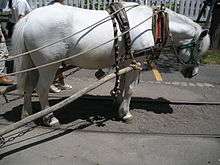Dosanko
The Dosanko (道産子), also known as the Hokkaido Horse (北海道馬, Hokkaidō uma) and Hokkaido Pony (北海ポニー, Hokkaidō ponī), is one of the eight extant indigenous horse breeds of Japan, and the only one of the eight not critically endangered.[1] It originated on the island of Hokkaido, in the far north of the country, and is found particularly along the Pacific (eastern) coast of the island.[2] The people of Hokkaido may be nicknamed "Dosanko" after the horses.[4]
 | |
| Other names | Hokkaido Horse[1] Hokkaido Pony[2] |
|---|---|
| Country of origin | Japan |
| Traits | |
| Distinguishing features | Average height: 132 cm[2] |
| Notes | |
| Conservation status, FAO (2007): not at risk[3] | |
History
The Dosanko is thought to derive from horses brought to the island from the Tōhoku region of north-eastern Honshu in the late Tokugawa period (1603–1868), and abandoned there.[4]
Total numbers of the breed grew from 1180 in 1973 to almost 3000 head in the early 1990s, but by the year 2000 had fallen to 1950 horses.[1] A herd book was established in 1979.[2] Hokkaido University receives a grant to study conservation measures for the breed.[1]
References
- [National Institute of Agrobiological Sciences] (2007). Country Report (For FAO State of the World’s Animal Genetic Resources Process), annex to: Barbara Rischkowsky, D. Pilling (eds.) (2007). The State of the World's Animal Genetic Resources for Food and Agriculture. Rome: Food and Agriculture Organization of the United Nations. ISBN 9789251057629. Accessed October 2014.
- Breed data sheet: Dosanko/Japan. Domestic Animal Diversity Information System of the Food and Agriculture Organization of the United Nations. Accessed October 2014.
- Barbara Rischkowsky, D. Pilling (eds.) (2007). List of breeds documented in the Global Databank for Animal Genetic Resources, annex to The State of the World's Animal Genetic Resources for Food and Agriculture. Rome: Food and Agriculture Organization of the United Nations. ISBN 9789251057629. Accessed October 2014.
- [Nihon Daigaku, Jinkō Kenkyūjo; Hokkaidō Daigaku] (1981). Planned population distribution for development: Hokkaido experience (Conference papers: report of the UNFPA/NUPRI International Seminar on Planned Population Distribution for Development: Hokkaido Experience, 19–23 May 1980, Sapporo, Japan, sponsored by the United Nations Fund for Population Activities, in collaboration with the Nihon University Population Research Institute and Hokkaido University). New York: United Nations Fund for Population Activities. p. 37. Accessed October 2014.